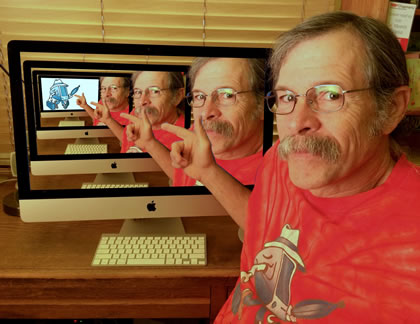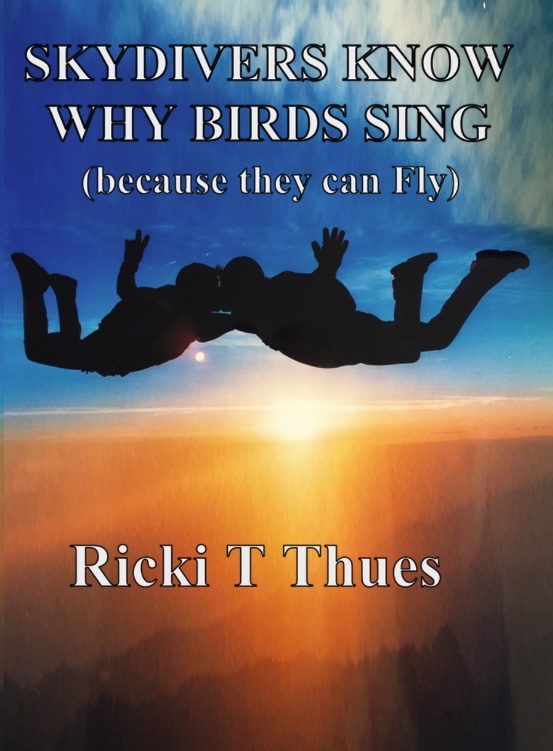Episode #796
May 4, 2024
Camping at Salton Sea, laying on a cot, my 8 year old mind watches the Milky Way spread out against the night sky. Satellites streak across the sparkling inky blackness. I fly along with them.
I am reading Space Cat at the library in the fifth grade. Flyball floats over to me in a spacewalk and high fives the glove of my spacesuit.
My neighborhood is laid out below me in my dream. I know it better from above, flying, than I do from the ground.
The doodles on my fifth-grade notebook are a Flash Gordon style spaceship with an astronaut tethered in a spacewalk.
My dream takes me out of the atmosphere and into the shining blackness. I round the moon, winking back at him while I fly back to my bed in my parents’ house.
I am perched on the edge of a 20’ tall waterfall in Hawaii. Inhaling deeply, I jump.
The air whistles in my ears as the world drops out from under me. I am suspended in space for an unexpectedly long time. The wall of the waterfall rushes next to me. As I contemplate my weightlessness a loud splashing sound envelops me. I am surrounded by liquid, still falling. I look up to watch the surface of the pool receding. Instinctively I kick my legs to propel myself up. I burst through the surface with a splashing pop of oxygen.
Paula vows to make a parachute jump. I add it to my bucket list as well.
We make our first jump at California City. It is the first stop in a road trip to the Grand Canyon.
In my Accelerated Free Fall (AFF) course I leave the airplane with two instructors.
“Check in. Check out. Ready. Set. Go.”
The air flows under me with full floating support. I look over to my main side instructor. He grins and puts a thumb up. I look to the reserve side. Grin. Thumbs up. I reach for my main parachute rip cord and do a practice pull. I reach for the reserve rip cord and do a practice pull. I stare at the horizon in awe of my windy weightlessness. A pointing finger appears in front of my eyes. Look, reach, grasp, pull. A rush of lines and fabric makes a strange ruffling sound as I decelerate from 120 mph vertical to 20 mph horizontal. It is suddenly quiet, and I am alone. The radio in my jumpsuit crackles. “Good job Rick. Now, make a slow right turn.” I pull down my right steering toggle and fly to the right. The wind brushes gently on my right side. “Straighten out. Do you see the drop zone? Slight left turn. Good. Straight in approach. Wait for it. Wait for it. FLARE!” I pull both toggles down. The parachute skims along the ground. I step out of the sky onto the desert floor.
Paula and I are sitting in the back of our pickup truck in a thunder and lightning storm over the Grand Canyon. It is magnificent. All we can do is talk about how it felt in freefall. We vow to finish the AFF program and become skydivers.
Our first 200 jumps have been spent zooming past each other in a desperate attempt to skydive together. It is difficult for us to fall together at the same speed. We are at a skydiving camp. My instructor puts some sleeves on my jumpsuit so I can fall slower and shows Paula how to fall faster by arching. “Relax Rick. The more relaxed you are, the better skydiver you will become.” This is the best advice I will ever receive.
We are participants in the 110 person starfish freefall formation. A ten-person star is at the center. Five twenty-way table top loops extend outward from the legs of the base people. On a signal, all ten people in the base drop their hand grips. The formation pulses out then stops in the shape of a giant starfish, floating in freefall.
Paula has been a participant of the Jump for the Cause all woman breast cancer fund raising skydiving events for four records over ten years. Mallory Lewis, the daughter of puppeteer Sheri Lewis works the puppet Lamb Chop to motivate the women.
It is the last day of the last event. Paula is in freefall with 180 other women. The formation builds quickly. It breathes and moves as each skydiver docks. Suddenly, the last jumper takes her grip. The formation pulses in slightly then relaxes into a solid, smoothly falling giant doily in the sky. They are once again world champions. This is the largest all women skydive in history. Even better, Jump for the Cause has raised nearly two million dollars for breast cancer research over the four events.
It is the end of one of my video skydives. I am wearing a Hanson camera helmet. It is mounted with a Canon Rebel SLR still camera and with a high eight video camera in the sheet metal housing. I wave off and pull. My helmet is immediately wedged off my head. I see it slowly rotating in front of me. As I reach out to grab the helmet it falls abruptly downward. My parachute opens quickly. As I watch my helmet fall away, I think, “I can cut away my main parachute, dive down to grab my helmet and then pull my reserve.” I shake my head thinking, “No Rick. That is just stupid.” I watch the helmet fall all the way to the ground, impacting with a puff of dust. As I land near my helmet, I see that it is hopelessly smashed. The video camera is crushed in the housing. I surmise from the broken bungee that the housing access door had opened and my parachute risers caught the door to wedge the helmet off my head. About 20 feet away is my Rebel, face down in the dirt. It looks intact. I walk over and pick up the camera. The glass lens optics flow out of the camera. I will not be taking pictures with this camera.
My long-time insurance agent is on the phone.
“Let me get this straight. You want to claim damage from an aircraft using your homeowner’s insurance.”
“That’s right. My parachute is an aircraft and it destroyed my helmet, video and still cameras.”
“I will see what the underwriters says.”
State Farm pays me $5000 to replace my camera gear. A year later my agent will call me to let me know that an exclusion for damage caused by a parachute has been added to their homeowner’s policies. He calls it the Thues clause.
Pat Works is an icon of skydiving, my mentor and my friend. We are wearing our new custom-made sit fly jump suits. They are one-piece shorts with long sleeved arms. Under the arms are small rectangular parachute shaped wings made with side panels connected with several ribs. This provides extra drag when sitting upright in freefall.
“When sitting in freefall,” says Pat, “align your spine like a stack of poker chips. Always remember, there is no up in freefall, so any body position is correct.” The double entendre does not escape me. You are always falling down, so there is no up. And head down or head up you are always equally weightless and correctly oriented.
We practice transitioning from belly to earth to a sitting position. Belly, cannon ball, sit. Arms out, spine straight, feet pushed down. We approach an 8-way belly to earth group while in our sit position, match speed, touch a leg, rotate around the formation and touch another leg. The 8-way hardly knows we are there.
Wayne Flemington was in the terrible Otter airplane crash at Perris airport. The accident left him paralyzed from the waist down. When he returned to skydiving, he bound his ankles together and rigged a lanyard to lift his feet when he landed. Sit flying is perfect for Wayne. He and I invent the “Flemington” airplane exit. Wayne sits in the door. I am poised in the door dangling from the hang bar. I insert my foot between his bound legs and cross my ankles. Ready. Set. Go. I let go, dragging Wayne out the door. For a moment I am head down and Wayne is standing. We stabilize with our backs to Earth. From here we can do barrel rolls or rotate 360s like a propeller.
D-Day Doll sits dramatically on the tarmac. It is the 60th anniversary of the Doll’s Normandy invasion flight. Our skydiving demonstration team is boarding D-Day Doll, a C-53D Air force version of the DC-3. An old gentleman with an Air force veteran hat taps me on the shoulder.
“Wish I was going with you,” he says.
“Maybe we can find you a rig,” I quip. “Why do you want to go?”
“I was on one of the D-Day glider tow missions to Utah beach on this airplane. I’m afraid I don’t jump anymore.”
“It is an honor to meet you sir,” I say, shaking his hand. I turn and board the airplane.
We are on jump run in Chicago. 14 airplanes are flying in formation to attempt a 246-person world record freefall formation.
The red light turns green and someone yells, “EXIT, EXIT, EXIT…”
I am the front floater, so I climb out through the door clutching a hang bar on the outside of the airplane. I look toward the lead aircraft.
In the lead airplane the captain of the base has poised his crew on the tailgate of the Skyvan. The superfloater clutches the plane behind the base with tiptoes on the tailgate.
The captain yells, “READY…SET…”
The superfloater lets go of the airplane. I let go of my plane.
“GO…” The base eight jump off the tailgate.
I face the 80 mile per hour prop blast and am immediately flying. As I peel left I spot the base, trailed by a string of skydivers.
5 seconds elapse.
The trails of skydivers from the other planes resolve in my view. I am now in free fall facing an 120 mile per hour vertical wind.
10 seconds.
Pulling my arms back and sticking out my legs I increase my horizontal speed and fly across space toward the formation. Others from the lead plane are approaching and docking on the base, clutching leg grips.
20 seconds.
I arrive near the fast-building formation, stop my relative motion and pause 10’ above and 30’ away. Scanning left and right, up and down, I see the person that I dock on pick up his grips.
25 seconds.
My legs stick out instinctively and I fly forward to my position (slot). Stopping just inches from my slot I take a deep breath.
My hands drop onto the leg grips. I am docked!
30 seconds.
Now is the time to fly my hardest. I must stay with the fluctuating fall rate of the formation. As more and more people dock the formation slows from 120 miles per hour to near 100 miles per hour.
40 seconds.
I cannot drag it down and I must not float it up. Tension is everywhere. A medieval rack must feel like this.
Everyone’s focus is on the center of the formation. I keep eye contact with my clone on the other side.
50 seconds.
The last person docks on the formation. There is a slight pulse inward, then calm. Pure quiet, accented with an 100 mile per hour wind. There is a real static electric current which flows through all our hands.
One second. Two seconds. Three seconds. Four seconds…
At 6,000 feet above the ground members of the base kick their legs in a signal to break off.
Skydivers on the outer edge of the formation let go, turn and fly (track) away. They will open their parachutes low, at 3,000 feet.
The next wave of jumpers turns and tracks. They open at 3,500 feet. My wave opens at 4,000 feet. The base opens at 4,500 feet.
From the ground the sound of 246 parachutes opening is like a freight train coming.
In the quiet of my parachute ride I hear other skydivers hooting and hollering. We all think the formation completed.
A carousel of parachutes spirals to the ground. We all land safely.
Back in the hangar we watch the video and the judges announce: “You all have just set a new 246 person world skydiving free fall formation record.”
We cry and we cheer.
The Easter Beer Hunt is an annual party that Paula and I throw. I have gathered 18 of my friends together. We are in the Elsinore DC-3 on jump run over Ike Arnold Park, three houses down from my house. I look down, spotting. There is my neighborhood, the park and a crowd of our neighbors and guests. A smoke canister on the ground indicates the wind direction. At 5,000 feet we will all do clear and pulls. I give the signal to cut back the engines. Skip, the pilot, throttles back the 3.
“Go,” I say, pointing at Paula. She jumps. 3 seconds and I say “Go” to the next jumper. When the last skydiver leaves the airplane I glance up at Skip, give him a salute and exit the plane.
1, 2, 3, 4, 5 seconds. I reach back and pull my pilot chute. Fabric rustles. My parachute opens. I join the carousel of parachutes. Paula is just landing. The cheer of the crowd floats up to me. We all land safely. The Easter Beer Hunt has begun.
Paula has gathered together new A licensed skydivers and visiting jumpers. I am jumping with her today. Paula is a Load Organizer at Skydive Perris. Her job is to organize skydivers, jump with them, debrief the skydive after the jump and keep skydivers jumping all day long. She walks us through a waltzing spider. Paula will be base in the middle. Four other jumpers will take arm and leg grips. At each signal skydivers will rotate their grips around Paula flying from arm to leg to leg to arm, etc. Now on jump run Paula spots and climbs out. We are all poised to exit. Paula says, “Ready, Set, Go!” We all leave the airplane. The spider builds quickly. We rotate all the way around Paula two times. Ya hoo!! On the ground, after Paula’s video debrief, three of our members are awarded a Waltzing Spider patch.
To make a skydive in all 50 US states has been on Paula and my bucket list for many decades. We are on a RV road trip through the Midwest in hopes of nearly completing that goal. We jumped in our 48th state two days ago in Minnesota. We have arrived in South Dakota after receiving a call yesterday from the DZ owner saying that they will have tandem students today. This is an occasional drop zone where every other Saturday they may or may not have a student. Several years ago we made a road trip to this drop zone, but the airplane was down and we could not jump. When we awoke this morning the clouds were moving in fast on the horizon.
The hanger door is open, the three tandem students are filling out paperwork, the DZO is gearing up, the pilot is prepping the Cessna.
I glance at the clouded horizon and ask if we can go on the first load with their first tandem. The instructor remembers us from years ago and says, “Absolutely, gear up and let’s go.”
The airplane struggles to climb with pilot, tandem master, student, Paula and I on board. We get to just above 9,000 feet and the instructor asks, “Is this high enough? We’re too heavy to go higher.” “Yes, of course,” I say. The pilot throws open the door and Paula and I jump. In freefall we hold hands and turn slow 360s taking in the magnificent South Dakota Black Hills landscape. I pull Paula to myself and kiss her long and hard. After we land, we find out that the pilot was able to give the tandem 11,500 feet after Paula and I left the plane.
State number 49! Only Hawaii remains in our quest for all 50 states. We hope to jump there next year.
IF YOU LIKE THIS BLOG YOU’LL LOVE MY BOOKS:
“Skydivers Know Why Birds Sing” by Ricki T Thues is now available on Amazon.
It is a Love story of Rick and Paula Thues and their 35 years of Skydiving.
Click HERE to buy the paperback or Kindle ebook at Amazon.
Follow Ricki T Thues on Amazon HERE.
ALSO AVAILABLE:
“Technically Human” by Ricki T Thues, the iMentor, is available on Amazon.
It is a compilation of selected episodes from this bLog which tell the story of Humanity through the eyes of the iMentor.
Click HERE to buy the paperback or Kindle ebook at Amazon.
The ebook version of “Technically Human” is also available on Kobo. Click HERE.
For you Barnes and Noble Nook readers it is available for Nook. Click HERE.
The “Technically Human” ebook is also available on Apple Books . Click HERE.





